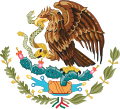Prior to 20th century
| History of Mexico |
|---|
 |
| Timeline |
- 1829 - Land grant to Santiago Argüello in 1829, establishing Rancho Tía Juana in what was then, Alta California.
- 1839 - Kumeyaay raid on Tijuana. [1]
- 1848 - End of the Mexican–American War. International border between US and Mexico formed north of Tijuana, Tijuana area is transferred to Baja California.
- 1889 - Tijuana founded in Baja California Territory.
- 1900 - Population: 243. [2]
